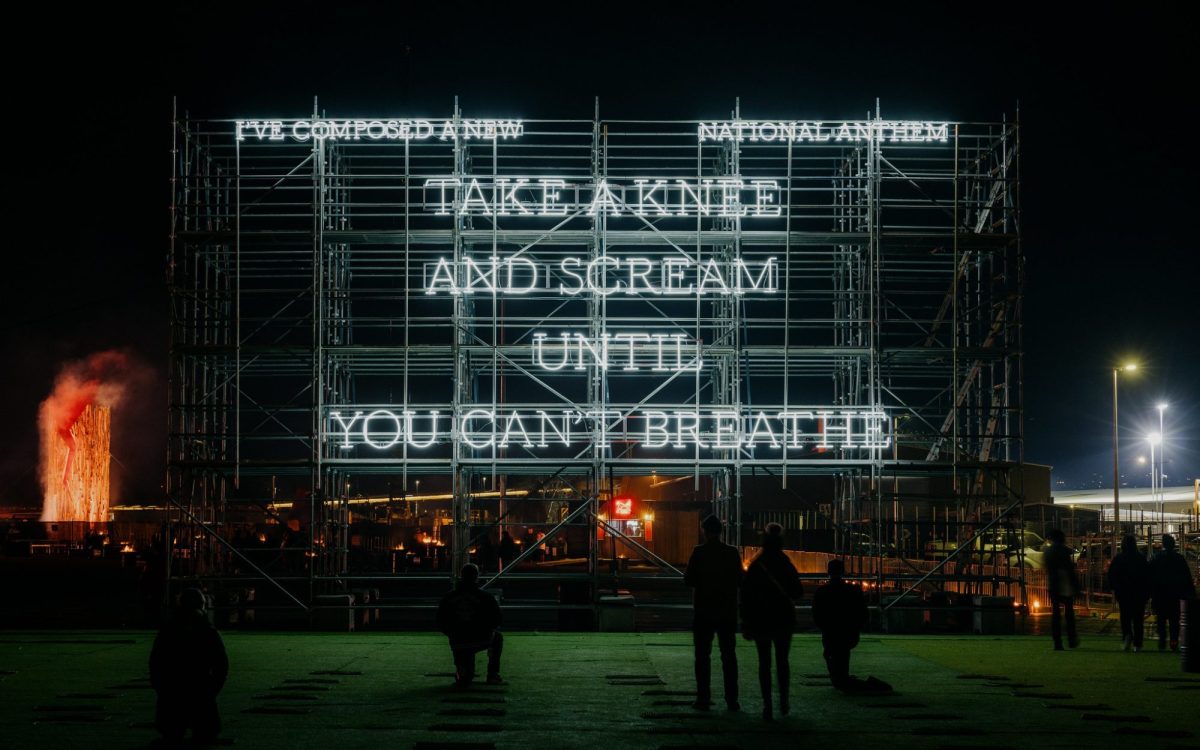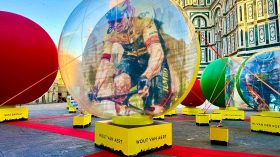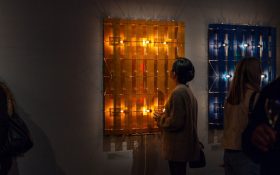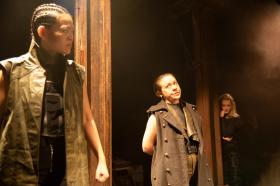Dark Mofo has returned from the dead and thriving under renewed enthusiasm with a crowd undeterred by the coldness and rain of Hobart’s winter. Music has always been its strong suit, and this year is perhaps no different with leadership under new Artistic Director, Chris Twite.
The (mostly free) visual art highlights open up current and topical conversations, cementing Dark Mofo as a festival that’s far beyond visual spectacles or simple pleasures.
Here is a round-up review of week one at Dark Mofo 2025, with the festival continuing until 15 June and ending with the signature Nude Solstice Swim on 21 June.
In this review:
Performing arts
Tierra Whack
From self-affirming lyrics to a milky shoey, Tierra Whack brought her fiery energy to the chilly Tasmanian city with a one-night performance of rap, R&B – and just music you could shout out loud and shake it off to.
The distance between fans and the star quickly disappeared as Whack got the audiences engaged after each one-minute song from her signature Whack World album. She was hilariously honest, almost a cross between a comedian and a singer, and wasn’t afraid to challenge the audience a little – who quickly got back at her with a theatre-wide request of a ‘shoey’, which Whack obliged in good spirits.
It’s not difficult to see Whack’s love of poetry – an interest that showed itself in her early days – through the stanza-like format of her lyrics, but the shyness of the younger artist has blossomed into someone who has absolute control of the stage.
Whack utilised her vocal strengths alongside the relatable storytelling, delivering top hits like ‘Pretty Ugly’, ‘Hungry Hippo’ and ‘TWO NIGHT’ and ‘BURNING BRAINS’ from the 2024 album WORLD WIDE WHACK to an enthusiastic audience who couldn’t get enough.
Tierra Whack performed on 8 June at the Odeon.
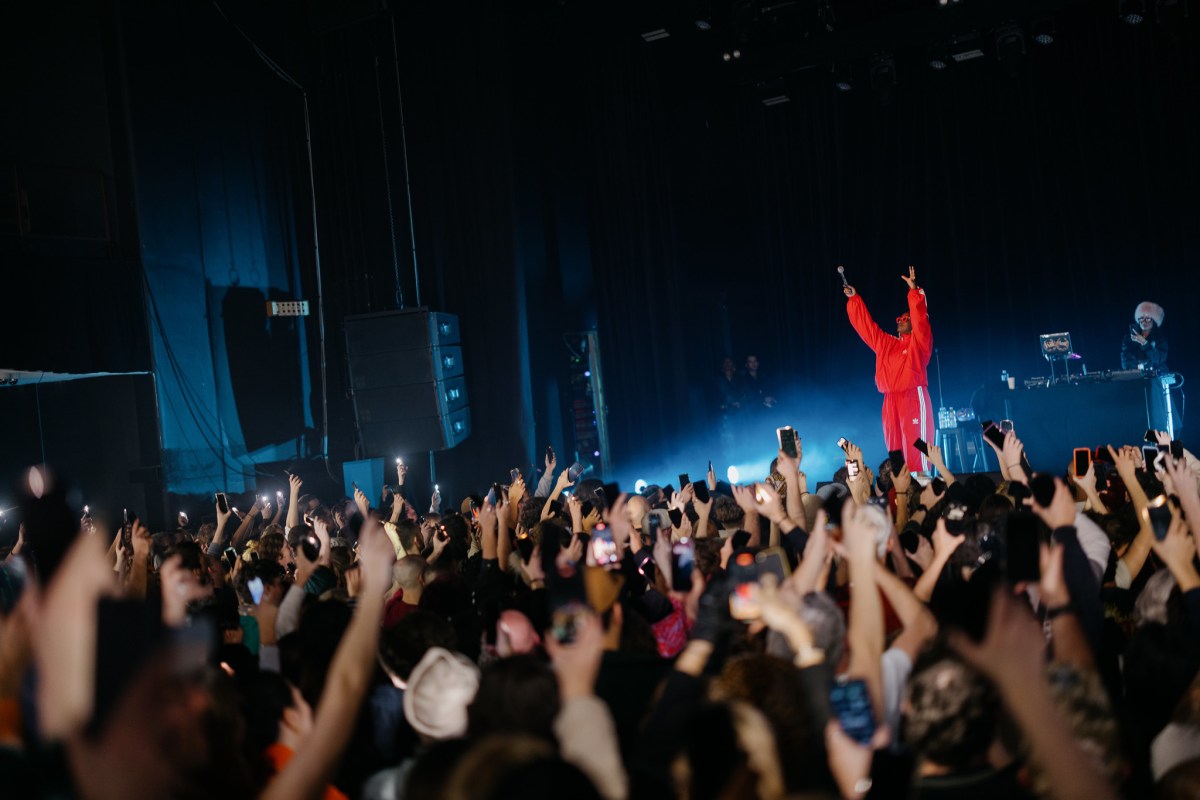
Landscape from Memory by Rival Consoles
British electronic music producer Rival Consoles blended intriguing visual projections with a dynamic set of synth riffs that provided multiple entry points for both diehard electronic fans and the casual appreciator.
Images of architectural blueprints and what seemed like MRI scans morphed in hypnotising synchronicity with the music, where even the shadow cast by the musician became animated by the beat. Rival Consoles treated the audience to a cinematic sonic experience, and himself, completely immersed in its creation.
Rival Consoles performed on 6 June at the Odeon.
Night Mass: God Complex
Night Mass is Dark Mofo’s cornerstone late-night music event that spreads its tentacles across multiple venues, forming a mysterious precinct with endless discoveries. The crowd may not be the usual Mofo art-viewing type, but Night Mass never lets you get away with just a night of simple pleasures. Instead, it pushes boundaries and comfort zones.
What’s been dubbed the ‘Rave Cave’ is a definite highlight of Night Mass: God Complex, with screens hanging hazardously among a jumble of tubes like some sort of cyborg factory, and different talent taking the stage throughout the event’s ungodly hours.
Elsewhere, puppets taunt you to film their act for that little doze of internet fame, while a waiver is signed with a whole crowd kneeling to watch someone getting their eyebrows shaved. There is a secret entrance where ravers can make their descent via a playground slide or, for the more introverted, a candy shop leads into a chill-out internet café.
Somehow, Night Mass effortlessly juggles the dichotomy of an event that is not for everyone, and yet, ensures that anyone who goes can have a good time.
Night Mass: God Complex runs on 6, 7, 13 and 14 June.
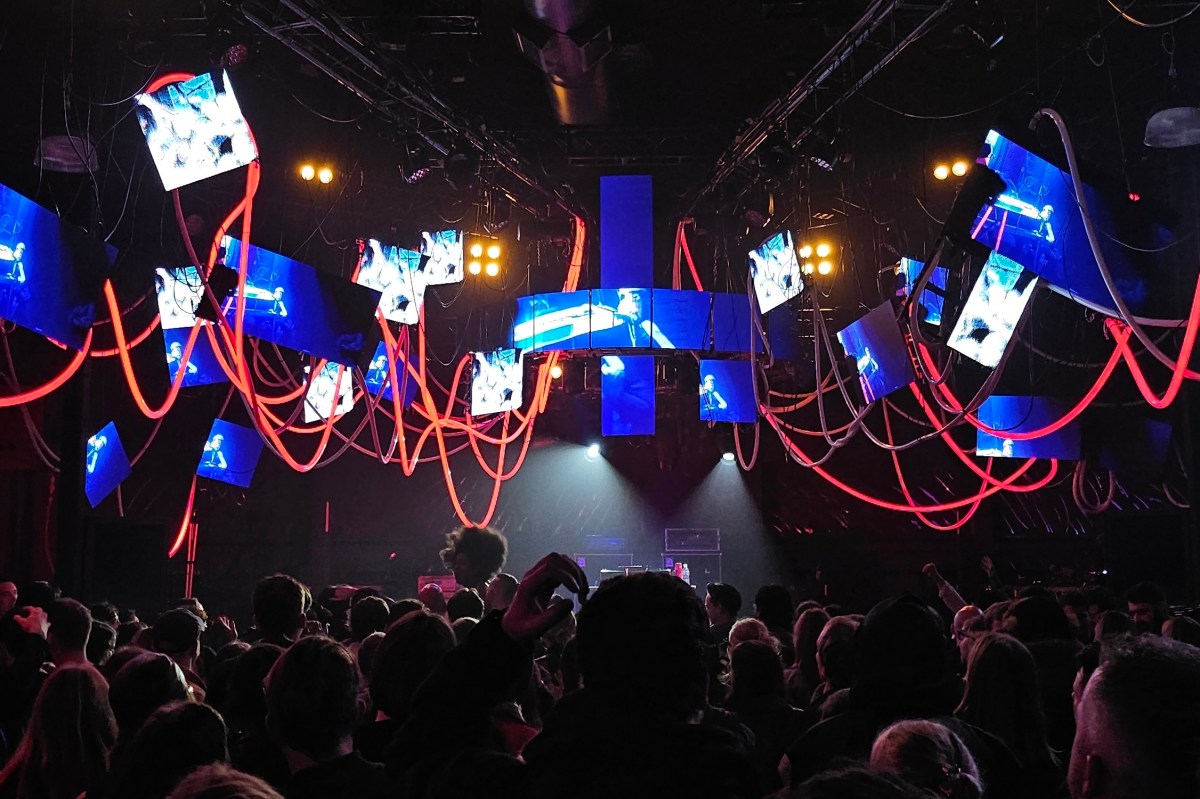
Void by Joshua Serafin
I have long been captivated by Joshua Serafin’s otherworldly performances where the Philippines-born multidisciplinary artist covers their body in petroleum-like slime and manipulates the substance into a surreal and sinister dance. Yet, it’s perhaps no surprise that these viral short clips on social media do not cover the full picture – Void is so much more than a visual spectacle, even if it’s sometimes difficult to see where all these pieces fit.
Void began with a near 20-minute prelude of an empty main stage – a time of slightly confusing stillness save for the two musicians playing on the balcony. Four vertical light beams washed the stage in neon blue, with a crater of dark liquid waiting to be activated by its artistic master.
A short film with three performers covering themselves in the dark liquid set the scene before Serafin emerged, stripped naked and ready to metamorphose with the slime, turning their body into a sort of identity void where things like gender and skin colour were overrode. In an earlier interview with Emil Cañita for To Be magazine, Serafin said, “…creating Void meant to diminish myself completely under this black background… I just wanted to be seen as an energy and to be seen as an abstraction, an enigma and not about my nationality, my gender or my face, because I feel like we enact the same violence to our bodies when we see it through a colonial gaze.“
Indeed, under the guise of this thick darkness that clung to their wildly choreographed form, Serafin became a force to be reckoned with, almost god-like. They allowed the audience to marvel as their twists and turns created air bubbles that blew up the slime into bulbous forms before they popped, and the black substance were flung out in all directions, following the movement of Serafin’s hair whips.
The audience was broken from this trance when Serafin stepped through the fourth wall and addressed us directly, sending out messages around oppression and the right to expression – whether that be around gender and sexuality, or artistic.
The punchline “If one body is not free, none of us are free” droned in the background as Void came to a close. It’s an important message – and a heartfelt one – but does an artist need to speak so explicitly about their values in the midst of their artwork or could this be left to the power of art to be interpreted, felt and reflected upon? Despite being sufficiently wowed by Void, this is the question that I felt compelled to include.
Void was performed from 5-8 June at Theatre Royal.
Visual arts
Chocolate Goblin by Travis Ficarra and Mortal Voice by Karina Utomo
Enter the Basilica and instantly come face to face with the glossy white thigh of a six-metre tall, naked, pregnant goblin. With dead-set eyes, sharp teeth and a nose that looks like it can pierce your heart, Travis Ficarra’s Chocolate Goblin is hypnotising in its sublimity, despite its conventional ugliness.
An extension of a similar work previously exhibited at Gertrude Glasshouse in Melbourne, this iteration includes the same cheeky peace fingers, but with an added bulging belly, speaking to its Hobart setting and perhaps hinting at an alternative representation of Mary.
Karina Utomo’s massive video installation of the artist making dramatic movements in slow motion and speaking in what almost sounds like Parseltongue sits directly opposite the goblin. The two pieces bounce off each other in dialogue, channelling feminine rage within the confines of this symbolic building.
The Basilica was open from 5-8 June, and again on 12, 13-15 June; free.
Karina Utomo will be doing a live performance at the Basilica on 12 June 6-6.30pm; free.
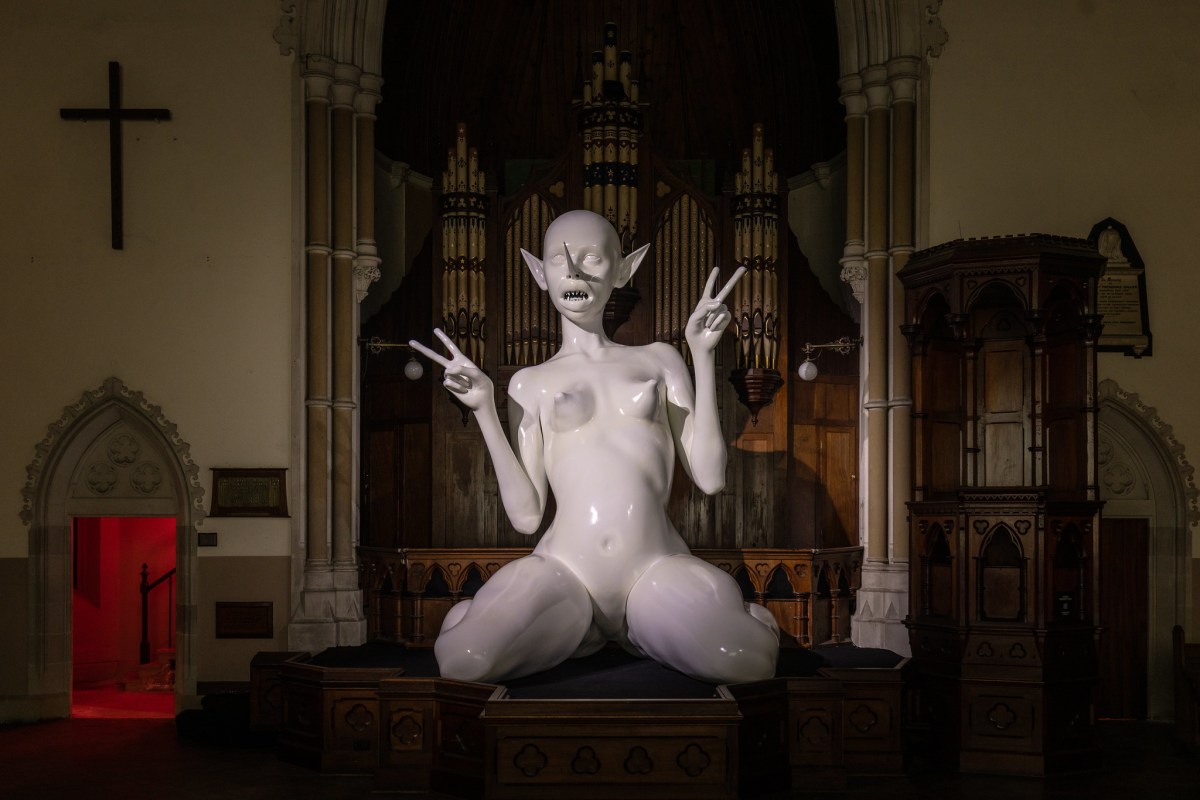
Cuerpo by Carlos Martiel and Because the knees bend by Paul Setubal
Systemic violence becomes bodily experiences at the Old Bank Building with works by Carlos Martiel and Paul Setubal.
Visitors are first invited downstairs for Setubal’s Because the knees bend, a simulation of violence and discipline where the artist wears a balaclava and assaults the walls of a corridor with his rubber baton – all while audiences are invited to make their way across the narrow walkway.
The sound alone is enough to make one jump, and the fine line between art and reality becomes scarily blurred. Setubal’s actions are aggressive, yet physically strenuous with the four-hour duration. As viewers look on, he too becomes the isolated animal trapped in a system that is cold-blooded and ruthless.
The exhilaration gives way to something more sobering upstairs, where only the strained shuffling of feet and laboured breaths can be heard in Martiel’s documented durational work, Cuerpo.
With hands behind his back and a noose around his neck, Martiel’s (black) body is precariously held up by a group of people desperately trying to save him from asphyxiation. Every couple of minutes, individuals step in and take over, giving each other a short break from the weight of a life on their shoulders.
Both works ask: ‘What is at stake, and how far will we go?’
The Old Bank opens from 5-8 June and 12-15 June; free.
Carlos Martiel will be doing a live durational performance, Custody, at City Hall on 14 June 7.30-9.30pm; free.
Dark Park
Dark Mofo’s annual free-entry theme park, Dark Park, this year brings several outstanding installations, including Nicholas Galanin’s Neon Anthem that gets attendees screaming as a form of catharsis and La Danse Macabre by Claudia Comte, an epic piano battle with fire and speed in video.
Close by, Ronnie van Hout’s Quasi, a metamorphosis of the artist’s hand and face, stands like a superhero on top of the building, looking at our humanly activities with mild amusement. Some have said that certain angles and the slightly pursed lips bring to mind a very controversial figure currently at the forefront of everyone’s minds, but that appears to be more of a coincidence that makes Quasi all the more mysterious and filled with speculation.
Light experience Sora by Nonotak is described as a representation of the Japanese night sky, yet bears resemblance to a previous work, Silent Symphony by United Visual Artists from Dark Mofo 2023. The same ambience and interstellar outlook makes it hard not to compare the two, with the earlier piece feeling more sublime and contextual. Sora is enjoyable nonetheless, and the children who decide to make the vast warehouse their stage just adds to the joy of the experience.
Dark Park opens from 5-8 June and 12-15 June; free.
We threw them down the rocks where they had thrown the sheep by Nathan Maynard
A tunnel that leads underground is filled with voices expressing their anger towards the treatment of First Peoples’ remains as specimens and objects of curiosity, before visitors come across rows upon rows of preserved sheep heads, sitting in jars on dimly lit racks.
The installation by Trawlwoolway man Nathan Maynard is the first work announced for Dark Mofo this year, previously generating backlash for its shock marketing. Seeing the work in person, it’s still somewhat unclear how the piece deals with the nuances of this conversation beyond the gore.
Does Maynard draw parallels between the sheep – symbolic for their meekness and, yet, heavily abused in the meat and wool industries – and what Indigenous people have suffered, so that people can understand the ongoing trauma and injustice; or is it simply swapping the violence between races to one that is between human and non-human species?
These questions no doubt dilute, or at least distract, away from the artist’s intention.
We threw them down the rocks where they had thrown the sheep is on view 5-7, 8, 12-14, and 15 June; free.
This writer travelled to Hobart as a guest of Mona.
